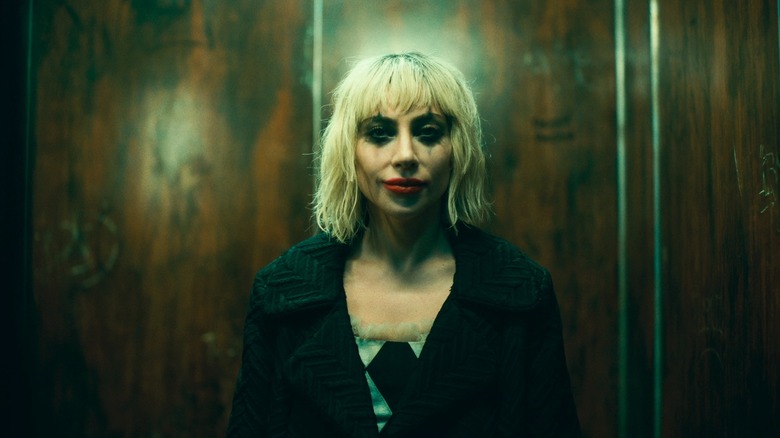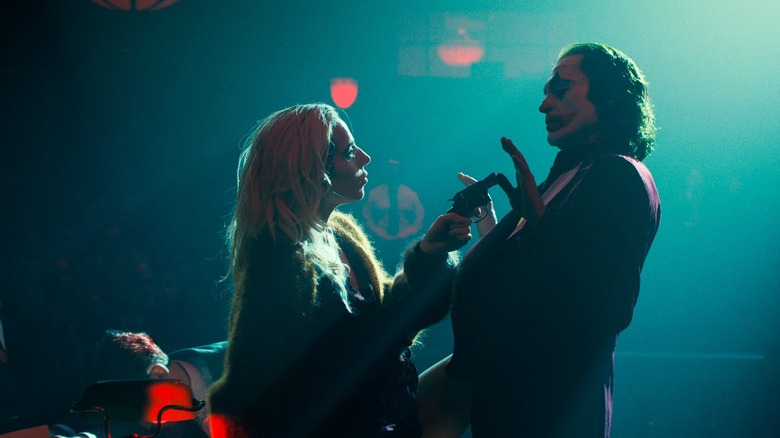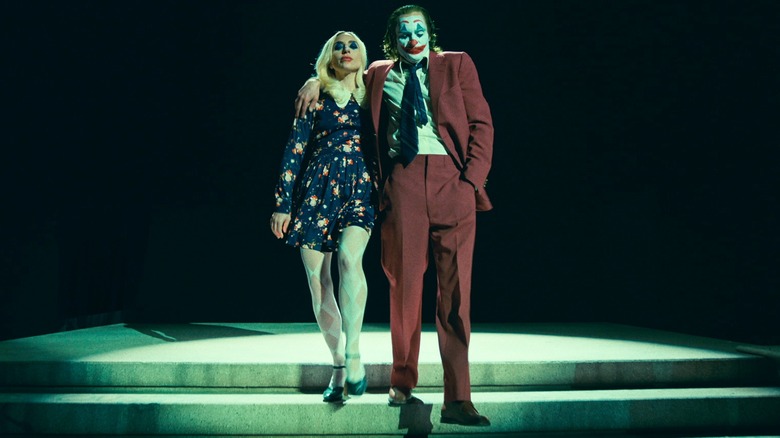How Joker 2 Completely Inverts The Comic Book Harley Quinn
This post contains spoilers for "Joker: Folie à Deux."
In 1992, Bruce Timm and Paul Dini created Harley Quinn for "Batman: The Animated Series," spinning a strange, complicated arc about a former psychiatrist being drawn to and manipulated by one of the most unpredictable criminals among Batman's rogues gallery: The Joker. Harley's actions, although seemingly stemming from personal agency, are impossible to dissect without the horribly abusive tint that colors her dynamic with the Joker, who exploits her empathy-based affection for him to use her as a discardable sidekick.
Harley's devotion to the clown prince never faltered, even when he was relentlessly cruel to her, repeatedly fed her to hyenas, physically assaulted her, and otherwise treated her like an object devoid of personhood. Every time Harley came close to acknowledging this abuse, which can be very complex and difficult for an abuse victim, Joker would manage to manipulate her with ease, as best exemplified in "Gotham City Sirens," where only a few faux-sweet words detract Harley from exacting revenge on him. The intent of these arcs has always been to highlight how unsavory and dangerous this push-and-pull dynamic has become, where one of Gotham's brightest minds falls prey to the noxious, manufactured charm of a methodical monster who uses her trauma to further his agendas.
However, as Harley became more fleshed out as a nuanced character in her own right — namely in "Mad Love," where we get her origin story — a need for her to reclaim her personhood was immensely felt. Her romantic relationship with Poison Ivy evolved into the key for her to break free of this abusive cycle with the Joker, and this was realized in myriad ways in various versions of her arc. 2016's "Suicide Squad" sets the foundation for her eventual self-reclamation (albeit in the most confusingly shallow manner), which culminates rather beautifully in "Birds of Prey," a film that allows Harley to be her most authentic self without Joker's shadow looming over her.
Does Todd Phillip's "Joker: Folie à Deux" follow the same path? On the contrary: The sequel to "Joker" completely rebrands and recontextualizes Harley's (an underutilized Lady Gaga) relationship with Arthur/Joker (Joaquin Phoenix) to complex, messy ends. Let us unpack this brand-new perspective on Harley Quinn.
Joker 2 situates Harley as someone thoroughly in control ... until it doesn't
In the somewhat promising first hour of "Joker: Folie à Deux," Arthur's world starts re-spinning on its own axis when he glimpses the mysterious Harley (Lee) in musical therapy, who promptly grabs his attention by mimicking a self-inflicted gunshot to the head. Before this, Arthur seems completely devoid of his simmering edge, as the horrors of Arkham have left him emptier than ever before. The attraction between the two is immediate, the kind that defies logic or expectations, but this is the crux of the film — the titular "folie à deux" — which hinges on shared mental illness and fantasy as opposed to a grounded mirroring of traditional attraction.
Right off the bat, Lee's presence is not poised as an opportunity for Arthur to use her for his whims, as she is an inmate at Arkham with a supposed criminal past, not an empathetic doctor enamored by her patient's suffering. Gaga plays Lee with a perfect blend of someone steeped in obsessive doting and concealing a malicious edge, as she is the one who has him wrapped around her finger, pushing Arthur towards embracing his Joker persona at the cost of everything that could have been. This fresh, completely inverted dynamic is the only interesting aspect of the film, especially when we learn her startling ability to deceive and turn Arthur against lawyer Maryanne Stewart (Catherine Keener) while stoking the embers of his need to be adored by the masses infected by Joker-fever.
The fact that Lee does not care about Arthur Fleck at all is a cruel yet compelling aspect of her fascination with Joker and Joker alone, to the point that even sex is a performance steeped in fantasy instead of an honest, intimate act. Even when caught in her lies, Lee doesn't falter, but reels Arthur in deeper, using pregnancy as a possible bait to root him in her lawless, anarchic vision. But Phillips builds up these worthwhile ideas only to discard them, pulling us into increasingly lackluster musical performances devoid of passion and a courtroom drama that drones on. Somewhere along the way, Lee's bright spark is dimmed, and her motivations feel as opaque and one-dimensional as the meaningless rehashing of Arthur's trauma that doesn't bother, or rather refuses, to delve deeper.
Fantasy and delusion are not enough to sustain this Joker-Harley duet
There are flashes of what could have been meaningful, such as Lee willfully embracing the comic-book-based red and black harlequin-esque costume, as opposed to being thrust into this identity by the Joker. She revels in Arthur's unraveling, goading him into fantastical extremes, which culminates in him acting as his defense attorney opposite the smug, young Harvey Dent (Harry Lawtey). She is the maker of her own mayhem, carefully guiding Arthur through the spectacle of his publicized trial. This, in turn, acts as fuel for the Joker lovers of Gotham, who use this opportunity to introduce more chaos into an already-escalating situation. Even in Arthur's highly stylized, surreal-adjacent musical fantasies, she is the one wielding true power, shooting him mid-performance when the integrity of these delusions starts to crumble.
However, none of these developments bear fruit, as Phillips comes very close to something resembling depth but quickly shies away from it. Lee's complete rejection of Arthur Fleck, the traumatized and abused child who grew up to willfully craft a larger-than-life persona to hurl the cruelties of life back at the world in the most violent way, could have led to a more hard-hitting payoff. The repeated use of "That's Entertainment" feels like a self-report of sorts, an annoying tongue-in-cheek mirroring of the film's half-baked themes, which leads to squandered potential, as both leads belt out committed performances despite being limited by the confines of the script. Even when Gaga unleashes her professional musical prowess, the results are startlingly hollow, as these sequences lack the character-driven panache that must come from the story, but never does.
The tension between the film's dogged determination to strip Joker of his iconographic status and Lee's obsessive need to mythologize him beyond recognition could have been a great juncture to explore in depth, allowing Lee to evolve into a character that is more than a cobbled-together idea that hinges on subversion. What we are left with, instead, is a missed opportunity that edges into the territory of an artistic chore, which is a feeling more empty than one would like to believe.
"Joker: Folie à Deux" is now playing in theaters.


